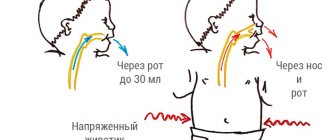09/23/2019 Reading time: 6 min 2452 0
- The main causes of regurgitation in children
- Pathological regurgitation
- How to distinguish regurgitation from vomiting
The most common cause of regurgitation is the structural features of the developing esophagus and stomach in a child in the first half of life, in particular weak muscles of the sphincter (valve) of the esophagus at the junction with the stomach. And the esophagus itself is relatively short and wide. The esophagus and stomach of a child at this age are compared to an “open bottle.”
Therefore, when overeating and (or) excessive air entering the stomach, when the child eats hastily and swallows air along with milk (or cries a lot before feeding), food from the stomach easily moves back into the oral cavity.
Regurgitation is observed, according to various sources, in 80–100% of infants under the age of 3 months. This is normal.
For example, American scientists estimate that regurgitation occurs in 100% of children aged 0 to 3 months, and in 20% of children it continues during the first year of life. In this case, the frequency of regurgitation after feeding ranges from 18 to 50%. In most children, regurgitation disappears or becomes much less frequent by the 4th–6th month of life.
Regurgitation, or regurgitation, is essentially the reflux of stomach contents into the pharynx, esophagus, and then into the oral cavity. Unlike vomiting, regurgitation is a passive process, that is, the muscles of the anterior abdominal wall, diaphragm and stomach are not involved in it. If a child spits up occasionally after feeding, this is normal and does not require special examinations, much less treatment.
It is important to understand two things. The first is how regurgitation (a natural process) differs from vomiting (can be a symptom of disorders in the body and diseases). The second is in what case even regurgitation is a reason to be wary. We'll talk about this below.
How to distinguish: regurgitation or vomiting in a baby?
Regurgitation of milk in a fountain in newborns is considered a normal physiological process. This phenomenon usually occurs in the first 6 months after birth. Some newborns may spit up like a fountain due to the absorption of large amounts of air while sucking on the mother's breast.
Also, the reason for regurgitation in breastfed newborns may lie in overeating, activity, or untimely transition from a horizontal to a vertical position.
Mommy should not worry if:
- The baby vomited up mother's milk, curdled mass or mixture.
- The volume of discharge does not exceed 30 ml.
- The mass does not have a strong unpleasant odor.
- An infant spits up like a fountain while eating or immediately after.
- There is no weight loss in the baby.
Important! If abundant curdled masses with impurities of bile, blood, and a strong unpleasant odor appear, you should consult a pediatrician. Also, do not postpone a visit to the doctor if your baby begins to lose weight.
Vomiting, in turn, is the eruption of the entire contents of the stomach. A one-time attack is not a cause for concern. If vomiting does not stop throughout the day, temperature fluctuations, lethargy, moodiness, and paleness of the baby’s skin occur, it can be assumed that there is a pathology in the child’s body:
- poisoning;
- intestinal obstruction;
- diseases of the central nervous system;
- metabolic disorders;
- infectious respiratory diseases.
To avoid regurgitation, mothers should keep the baby in an upright position after feeding.
Regurgitation
My baby is spitting up - is this normal?
Many newborn babies spit up milk.
This can happen either immediately after feeding or within 1-2 hours after feeding (the baby may vomit “fresh” or curdled milk). About 70% of children under the age of 3-6 months regurgitate during and after feedings, and most often the regurgitation ends by only 9-12 months. Regurgitation often looks much more profuse than it actually is. You can try pouring a few teaspoons onto the diaper and evaluate the wet spot, comparing it with stains on diapers that are usually the result of spitting up - this amount of spitting up is considered normal.
In most cases, regurgitation is associated with the immaturity of the child’s body or with the organization of his feeding. feedings in large portions (when feeding according to a schedule, feeding from a bottle) often lead to regurgitation swallowing large amounts of air during feeding (due to improper latching or using a bottle).
Also, newborns may have somatic features that increase the likelihood of regurgitation or cause excessive regurgitation: abnormalities in the development of the gastrointestinal tract in infants, damage to the nervous system during pregnancy or childbirth, metabolic disorders, viral and bacterial infections, etc. These are quite rare causes of regurgitation, and they will be excluded by a neonatologist, pediatrician and pediatric surgeon during the postnatal monitoring of the baby.
If regurgitation causes concern, then first of all you need to exclude possible somatic causes together with doctors, and also contact a lactation consultant to optimize the organization of breastfeeding - checking the correct attachment, selecting positions for feeding, and so on.
Tips for spitting up.
- Breastfeed











